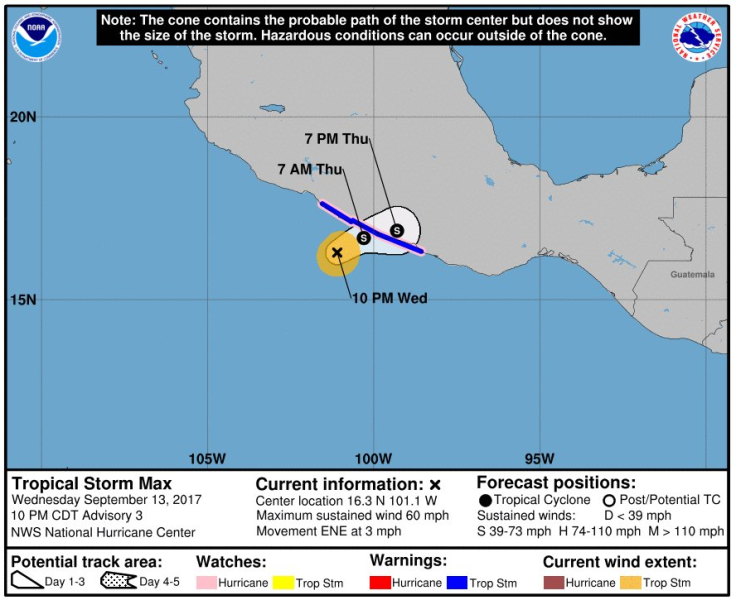Where Is Hurricane Max Going And When Will It Hit?

While Hurricane Irma has ceased its wrath in the United States, elsewhere in the world yet another hurricane is on its way. Hurricane Max formed off Mexico’s southern Pacific coast and was expected to make landfall sometime Thursday afternoon.
Situated 55 miles southwest of Acapulco Thursday morning, Max carried winds of about 75 mph, making it a Category 1 storm, according to the National Hurricane Center. A hurricane warning remained in effect for the coastline between Zihuataneio and Punta Maldonado.
Hurricane #Max Advisory 5: Max Becomes a Hurricane. Hurricane Warning Issued For the Southwestern Coast of Mexico. https://t.co/mbw53R5dme
— NHC Eastern Pacific (@NHC_Pacific) September 14, 2017
Max could bring potentially destructive rainfall to an area still reeling from an 8.1 earthquake that struck last week. The quake left at least 96 people dead in Oaxaca, Chiapas and Tabasco, according to Reuters. Max’s arrival could bring up to six inches in some places, according to AccuWeather, making it more difficult to efficiently clean up areas affected by the earthquake and could potentially cause destruction in the form of flooding or landslides.
“Max will bring the biggest threat for flooding across the state of Guerrero, including Acapulco, into Friday morning,” said AccuWeather meteorologist Steve D. Travis.
Once Max makes landfall it would likely weaken as a result of mountainous terrain. Even as it weakens, however, it could still bring tropical moisture to areas from coastal Michoacan to southern Oaxaca.
Meanwhile, yet another storm could be hot on Max’s heels. Just to the west, an area of low pressure could potentially turn into a hurricane thanks to warm water and ideal winds.
“While the track is not set in stone, it could move northward toward the Baja Peninsula or western Mexico late in the weekend,” said Travis.
This year’s hurricane season has been particularly destructive thanks to the strength and longevity of some of the most severe storms. Hurricane Harvey brought a record amount of rainfall when it landed in Texas in August, while Hurricane Irma smashed through the Caribbean and Florida with record breaking winds of 185 mph for 37 hours.
#Max expected to be near hurricane strength when it makes landfall tomorrow. Mexico has issued a hurricane watch for its SW coast. pic.twitter.com/epJd28avU7
— NHC Eastern Pacific (@NHC_Pacific) September 14, 2017
© Copyright IBTimes 2025. All rights reserved.






















